C. Aubrey Hall's Blog, page 41
July 31, 2011
Bored with the 'Board
Ever sit down at the computer keyboard with no enthusiasm for your writing session?
Ever start up the computer while you feel absolutely blank about what you're going to write today?
Ever catch yourself falling asleep or getting drowsy while you're typing?
When you read back over a sentence you've just typed, does it fail to make sense?
Oops. The boredom factor is at work.
If you're bored, unprepared, blank, tired, sleepy, or otherwise disconnected from your story, how do you think the writing is going to go?
Lousy.
Solution:
1) Ask yourself why you are no longer interested in your characters.
2) Ask yourself what should be happening in the story but isn't.
3) Ask yourself if you should replot your scene-in-progress, and maybe throw in some unpredictability, plot twists, heightened conflict, or story complications to liven it up.
4) Ask yourself why you aren't thinking about your story before you sit down for your writing time. Is there a lot on your mind? Are you distracted by other matters? If so, clear them away.
5) Ask yourself why you don't feel the zing that a good, solid, creative session should generate.
Put the answers in your journal. Be honest.

This old machine dates back to the 1920s.
Maybe you've made a plotting mistake, and your story sense is trying to put on the brakes before you write too many words that have to be thrown out.
Maybe you're writing this story for all the wrong reasons, and your head is engaged but not your heart. Like all such relationships, this one is headed for disaster. How can you get the love back? Or should you hit "delete" and walk away?
Maybe you're sleep deprived and kidding yourself that you can handle it. I can't give you the title or date, but a study was conducted a few years ago that showed sleep deprivation as a cause of diminishing creativity.
For whatever reason, consider this state a warning sign to be heeded. Ignore it at the risk of imperiling your story. Even if you're one of those stubborn types determined to persist at pounding out your daily quota pages without rectifying the problem, you're likely to produce work that will read as shoddy, repetitive, bland, blah, and unimaginative. In other words: meh.
Our writing mirrors us emotionally. If we're bored at the keyboard, readers are going to be snoring even more than we are.
Take care.








July 27, 2011
Self-Training
In my blog entry, "Filling the Well," I included a long list of ways in which to keep your imagination humming. The last entry on that list suggested that you pick a favorite novel and type the first three chapters.
Sounds like drudgery homework, doesn't it?
It's not.
Years ago, I came across a quote that I can only paraphrase now. But it was something along the lines of you can judge whether you've found your true calling if you enjoy even the tedious aspects of that profession or task.
It's important to keep your writing skills honed. We work so hard to acquire them, yet they can go rusty in two weeks. So writers must always be practicing and learning the craft.
In doing so, you will also keep your imagination toned and ready to supply you with ideas.
Now, you don't type another author's story to steal it. You type it to get a close feel for how this writer puts sentences together, how the words flow, how the paragraphs link, how the scene conflict unfolds, or how the dialogue rambles or snaps.
You may be thinking, Is she out of her mind? Type three chapters? Use hours of potential writing time, typing some rich author's work? I can see what Arthur Author's doing without going to all that trouble and effort!
Can you?
You'll see something, but you won't get close enough until you practice it.
Case in point: earlier this summer I wanted a strong opening hook for a story I was working on.
The best novel-opening hook I can think of is the first sentence of John D. MacDonald's DARKER THAN AMBER.
"We were about to give up and call it a night when somebody dropped the girl off the bridge."
There it is. A simple, effective, well-written sentence that conveys just enough to grab your interest and make you want to read the next paragraph.
Now, sure. I can read and reread that sentence. But I wanted the cadence of the words. I wanted that rhythm for my own. So I typed the sentence several times, then I placed my own opening sentence next to it and tweaked and edited until I achieved the effect I wanted.
Plagiarism? Not at all. I'm not writing the SAME sentence. I'm not writing the same plot, or setting, or genre, or characters.
All I took away from Mr. MacDonald was the rhythm, cadence, and pattern of how the sentence flows.
(Am I going to share my sentence with you? Sorry, no. Chalk it up to an old superstition of mine–no sharing until publication.)
If you want to learn how to launch a novel, type the first three chapters of the best book you can think of. Get a feel for it, where the breaks are, how the scenes or description move.
If you want to learn how to write good description or good dialogue, type the best examples you can find and compare your efforts to them.
This exercise doesn't work if you don't type the excerpt from the published material.

Opening sentence: The day I decided to steal a dog was the same day my best friend, Luanne Godfrey, found out I lived in a car.
If you want to teach yourself how to plot, type the whole book that you've chosen as your template.
Yes. From start to finish, type the thing. It will teach you more than you can imagine.
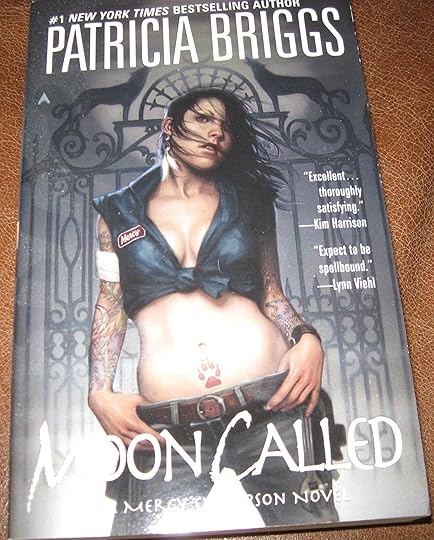
Opening: I didn't realize he was a werewolf at first. My nose isn't at its best when surrounded by axle grease and burnt oil ...

Opening: Bailey was not surprised when the doctor's first incision drew up something darker than blood.








July 15, 2011
The Fear Factor
We writers are a complicated bunch. We're sensitive, imaginative, and creative. Although those qualities allow us to cook up plotlines and characters, they also get us into trouble.
Because we can imagine more doubts, fears, insecurities, and bogeymen than just about anyone else in the population.
To consider how imagination can derail us, let's look at one of my dogs as an example.
His nickname is "Spook." Now, as a breed, scotties are smart dogs. They're also stubborn and independent, which can make them seem–at times–less intelligent than they really are. The Spook, however, is smarter than most and also imaginative. This resulted in a puppyhood filled with all sorts of crises:

Here's "The Spook," a Scottish terrier with too much imagination.
Bark! There's a monster in the bathroom! (A pile of sorted dirty clothes about to be taken to the washer.)
Bark! There's a woman screaming in the house. (I had to cut out watching suspense films until the Spook grew older.)
Bark! There's a stranger in the house. (My father wearing a cap.)
Bark! That trashbag's going to swallow me, and I'll never be seen again.
Bark! I'm going to go down the bathtub drain. Help me! Help me!
Bark! Can't you see what's standing there? (No, Spook, there's nothing in the room but you, me, and the furniture.)
Some of these examples are normal puppy frights and some–such as staring into space and reacting to what simply wasn't there–aren't. The Spook's behavior was all the more noticeable because his littermate didn't react to any of these so-called dangers, except that scary, rattling trashbag.
These days, I've learned that the Spook is what Cesar Milan would call a dog with unstable energy. The Spook runs around, overreacting to the slightest stimulation and making up the rest. I had to learn to step up and be very much the alpha pack leader in order for the Spook to feel more secure. However, the point is that the Spook suffers from too much imagination, and he's firmly convinced that he could operate the TV remote if only I'd let him push those little buttons.

Too hot and sleepy today to be afraid.
I, too, have more imagination than is probably good for me. As a writer, it's my job to make up scenarios of escalating trouble for my characters to confront. As a writer, it is not my job to make up scenarios of escalating trouble for myself.
When I'm teaching, a lot of my tutorial sessions with individual students revolves around coaching them through whatever's holding them back. They have fears–sometimes big ones–even if their Joe Cool College Dude persona won't let them admit it.
-They're afraid they're going to make a mistake. Get over it! You can't learn unless you mess up. You can't grow unless you try new things.
I had a grandfather that waited, ready to pounce on the slightest misstep so he could tease us mercilessly about it for years. Family members learned to be skilled and successful at what they did. They also learned to be hesitant, less-than-confident, and inclined to practice in secret or not try at all.
-My students are afraid they'll be laughed at. By whom? Who's sitting around in New York publishing offices, saying, "I hope a new manuscript lands on my desk today so I can har-har at it?" Editors don't have time for that; and even if they did, they aren't cruel people; and even if they were, you'll never know because you aren't there.
-My students are afraid of criticism. Get past that one, too. Chances are, if you really burn to write, then you really burn to be read.
That means, somewhere inside you is the dream of seeing your name on a book cover, on a shelf, in a store, in an airport rack, on a Walmart shelf, in the library, at amazon.com, and–most importantly–in someone's Nook.
However, if your name is on a book and people are reading it, then not everyone is going to love it. You'll get good reviews, enthusiastic reviews, lukewarm reviews, and scathing reviews. You'll have to suffer through unkind comments written by amazon.com customers who may decide they hate your opening paragraph and want to slay you online.
The cruel, unjustified criticism hurts. Let no one claim differently. Constructive criticism stings but it helps you improve. You need honest feedback. You need to know if what you've written doesn't make sense, or is lame, or requires tightening.
-My students are afraid of their own feelings. I call this the "apathy factor." By the time students reach my writing classroom, they have usually mastered the art of deadpanning their indifference to adults.
Here's a little secret: You can't write well if you don't feel.
Granted, emotions are messy. They are disdained or unwelcome in public. We're supposed to control them, manage them, and unleash them only when appropriate. Because society can become too bottled up, it seeks emotional outlets such as reading fiction to let off the steam.
Which means, fiction shouldn't be bottled up. Characters need to feel their emotions in a big way, but they won't be well-drawn or plausible if their author is afraid to feel with them and plays it safe.
-My students are afraid of success. What's this about? I dunno. Maybe it ties in with shyness, not wanting to be noticed. Because of course if you are noticed, then you might mess up and then everyone will know that your first success was a fluke.
How do you get past this one? I can't tell you. I'm not a trained counselor. I think you have to find a way to push yourself past your comfort zone and just try.
There are plenty of self-help books for writers out there. Steven Pressfield's THE WAR OF ART is a good one.
-My students fear they aren't good enough. That's a really big, insidious, reach-down-into-your-guts-and-eat-you-alive fear, all right. It can jeer at you in the back of your mind, cause you to second-guess every word you write, and keep you tied in knots.
So what you do to face down this worry is master writing craft. Practice, read, practice, practice, read, and practice some more. You have no excuse for not knowing how to construct good sentences or to spell and punctuate properly. None. There aren't that many rules. If no one ever taught you, then teach yourself.
Train your story sense by watching well-written films about people working through their problems. Vincent Minnelli's last movie, THE COURTSHIP OF EDDIE'S FATHER, starring Glen Ford, Shirley Jones, and Ronnie Howard, is a good example of emotion, character growth, solid plotting, and how to mix tears with humor.
You have to read. And read. And read.
When you know story craft, when you've written the best plot that's in you about the best characters you've ever devised, and you haven't held back–what's to stop you from being good enough?
And after all that, if you aren't trendy enough, chances are there will still be a publisher willing to take your story. Or, if you choose to self-publish on Kindle, there will be people willing to read your story.
All I know is that you can't write your best at half-throttle, afraid to take chances, afraid to believe in yourself, afraid to listen to your own instincts.
Go for it, every time. You're never too sensitive, too delicate, too shy, too frail to really try.

These petunias are about the only flowers I've got not wilting in the heat.








July 11, 2011
In Praise of Ink

Sleek, cool, sophisticated. The Cross fountain pen.
How long will it be until pens and ink are extinct? Writing paper is all but gone, as people abandon the romance of the written love letter for the cold brevity of emails or the semi-illiteracy of text messaging. Pens are surely on the endangered list.
These days, instead of selecting a proper pen with the right barrel size to best fit our hand and thus reduce fatigue, we exercise our thumbs on miniscule touchpads.
Now, back when I was a mere tadpole in the pond of aspiring writers, personal computers did not as yet exist. The highest state of technology writers had was the now-defunct typewriter. (Did you know the last typewriter manufacturer stopped production this year?) Instead of computer courses, my generation was offered high school typing and shorthand.

This little portable Royal typewriter belonged to my grandfather. Isn't it a cutie?
My parents wouldn't let me play on the typewriter, despite my proclaimed intention of being a writer. They said I had to take typing class and learn properly. (Thanks, Mom and Dad! Today, I am one lean, mean touch-typing machine.)
So, for most of my youth, I had little option but to use pen and paper in composing my stories. Eventually, I purchased a manual portable Smith Corona typewriter, eschewing the electric model in case I wanted to write on a deserted island without electricity. But I found that such romantic notions are often inefficient ones. For college, I invested in an electric typewriter that proved too frail for the amount of typing I dished out. Unfortunately, I found I hated composing on the typewriter. It was too noisy, too clunky. The machine got in the way of my story sense.
So I continued to write stories by hand.
Thus, I came to know pens. Fountain pens that leaked blue ink on my fingers. Ballpoints that either glided or sputtered in skips and blobs. Felt tips that were too expensive but came in "wild" colors such as red or green. I learned that I loathed Bic stick pens and preferred PaperMates instead.
Later on, when gel ink came along, so many varieties skipped and stalled that I refused to write with them for a long time. Even now, in gels I'll use only the Pilot G-2, Sarasa, or Parker gel ink refills. There are such exotic colors! For cheap ballpoints, I favor the Bic Velocity.
For years, I scribbled my novels on ruled notebook paper or blank sheets of typing paper. Yes, I wrote the entire first draft by hand. If I had the whole chapter planned ahead of time, I could write a 10-page scene in about three hours.
Then, fingers cramped and elbow aching, I would stop. The middle finger on my right hand developed a knot at the first knuckle from the way I held my pen. I told myself that the ink stains on my skin connected me to great writers of the past, like Samuel Johnson and Edgar Allen Poe.
Once the rough draft–in however many versions it took–was completed, I would laboriously type the whole manuscript, edit and polish it, and type it again for submission.
Fortunately, when computers became affordable, I found that I could compose on them. But I didn't lose my love of pens.
Presently there are far too many scattered around the house. When I moved last year, it was a shock to pull all the pens and boxes of pens from my office supply closet and realize I needed an entire cardboard box to pack them in.
I like green gel-ink pens for editing. In a second run through, I'll switch to hot pink.
I use a lapis-blue Tornado pen for my journal and a brushed silver one for personal correspondance. Last Christmas, I received a Tornado covered with embossed lavender leather–very pretty!
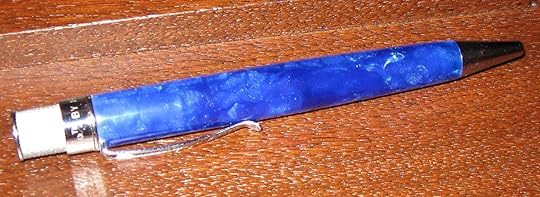
Here's my beloved blue Tornado pen. The silver one is temporarily misplaced. The lavender one would NOT photograph.
And then there's the fountain pen collection. Several years ago, I succumbed to temptation and bought a real fountain pen instead of those cheap, leaky ones available in discount stores.

This is the Shaeffer with the extra fine nib. Such a small nib means the ink can't flow well, so writing with it is scratchy. That can feel authentically old-fashioned.
There's the Shaeffer with the extra-fine nib that squeaks as I write spidery-thin notes in Christmas cards. There's also the elegant Waterman with a hard-working steel nib.

Who knew that loading this pen with ink could be so challenging? But it writes like a dream. Smooth, smooth, smooth.
And there's the Parker (shown above), a handsome pen indeed that required several months of layaway payments. It has a gold nib that's supposed to conform to the way I write–how much pressure I use in bearing down on the paper, etc. I confess that I'm a little intimidated by such a regal pen and seldom use it.
There's the cleaning of the nib, for one thing. Then I face the ritual of filling the pen with ink from a bottle–something I've never quite mastered. (No drop-in cartridge on this baby! It has an internal bladder and by practice and magic you siphon the ink up into the barrel.) And of course, there's the fear that this pen will get lost, knocked off my desk by accident, or carried off by someone who hasn't a clue of what it cost.

The Parker pen.
So the magnificent Parker resides in the fire safe, where it's of no use–let alone inspiration–at all. That's no way to treat a good pen.
Someday, once the desk is properly cleared and I invest in an elegant desk set, then perhaps I'll take the Parker out and use it.
A thriller novelist named Robert L. Duncan was one of my writing teachers, also the coach who helped me get my first literary agent. Bob usually wrote his novels on index cards with a Flair felt-tip pen. He told me of how, one Christmas, his wife gave him a beautiful pen and said, "This pen contains your next book."
How charming is that? And what could be more inspiring?

July 4, 2011
Ode to Paper
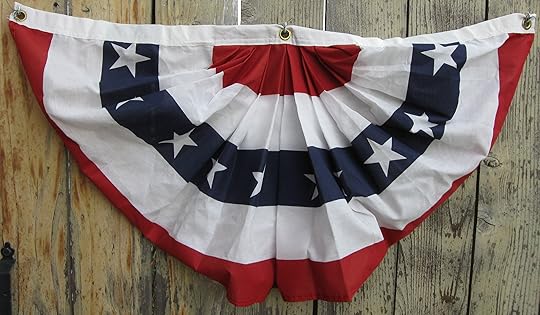
Happy 4th of July!
In my previous blog entry, I wrote about keeping journals as a way to stay creative and focused.
There's another benefit beyond feeding the muse, and that's the joy of collecting journals themselves. Do you journal on your computer or any old scrap of paper that comes your way? Are you trying to be creatively practical by journaling on the back of junk-mail envelopes? No good!
My first memory of becoming persnickety about the paper I write on stems from first grade and the first week of school. Pre-school didn't exist when I was a child, and I didn't attend kindergarten, so my formal education began at age six.
My mom assures me that I was keen to go. All I remember is that within the first hour I was tired of being cooped up, especially when I learned–the hard way–that I wasn't allowed to leave the room or the building whenever I pleased. By lunchtime, I'd had enough!
But this is about paper, not my early disillusionment with the educational system.
After that first day, Mom and I went to the store to buy pencils and a spiral notebook. I remember wanting an aqua-blue one because it had silky-smooth paper. I instinctively knew that the paper quality was far superior to the red notebook Mom favored. She chose the red one because it cost less, and nothing I said convinced her to buy the aqua one.
That first notebook launched a year of disappointment as I scratched my laborious way over the rough, cheaply pressed fibers, practicing my letters and the rudiments of arithmetic. I became a paper snob.
To this day, when I purchase writing paper or journals, certain little subjective tests have to be passed. It always starts with the paper. How smooth is it? Has it been coated? Does it have a texture? Is it flimsy or thick weight? Is the ink going to glide or smear?
Are the pages blank or lined? If I'm going to make work-in-progress notes, I want the pages college-ruled. Wide-ruled turns me off, and always has. If I'm going to write in a journal, I want blank pages with no lines at all. Lines are regimental and force a conformity that has no place in my free-writing entries.
How tight is the binding? In spiral notebooks, I want to flip to the center and see the pages slightly sticking together along the perforations for the wire binding. That tells me the notebook is new and hasn't been over-handled before it comes to me. The pages are clean and very, very fresh. They will receive my ideas well.
In journals, I dislike spiral bindings that lie flat. I like a journal that's sewn or glued like a hardcover book. I want to have to wrestle a little with it to write deep in the central gutter. I want it to be stiff, like a book that hasn't been opened before.

I prefer these two journal types over all the rest. The blue one is a hardbound sketchbook covered in buckram cloth, small, durable, and acid free. The black one is much fancier with a leather cover that goes over soft-bound refills.
Last, but hardly least, I mull over the cover. Cheap composition notebooks–admittedly flimsy and designed to be disposable–now come in snazzy colors and graphics. I use them as I develop new fiction ideas. I can list potential character names and work out their spellings. I can draw maps, inject paragraphs of description, figure out my protagonist's family tree, and draft a few pages of character introduction.
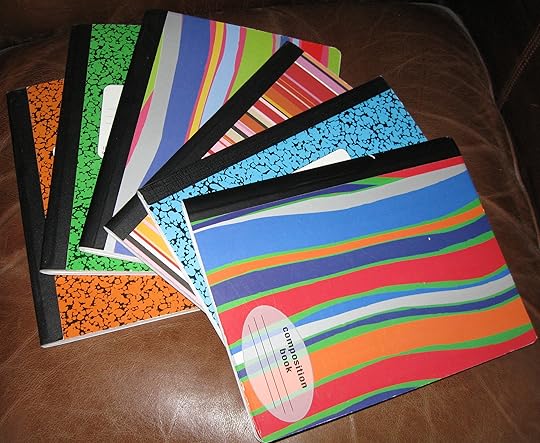
These notebooks are easy to carry. I hate that their pages are wide-ruled, but the colors inspire me.
When purchasing composition notebooks, I pick colors and designs that are fun and make me happy. I figure if I smile when I see them, I'll be more inclined to pick one up and work. Each idea-in-development is assigned its own color, so I can reference them easily. And if I happen to have the wrong idea book with me when inspiration strikes and I scribble notes anyway, it's no trouble to tear out the page and stick it in the correct notebook later. After all, these are working books and far from cherished.
When it comes to a journal, however, the cover is very important. It has to be beautiful or stately, worthy in some indefinable way of my most secret musings. In other words, I don't want cute bunnies cavorting on the cover, or Mary Englebreit designs however appealing, or glitter. That isn't to say I don't have such journals, but they're for other purposes in my life than my innermost thoughts.
For example, when I got my first dog–a feisty little Scottish terrier–I kept a journal of his first year. It was his baby book, if you will, and bound in gray, black, and scarlet plaid cloth. The appropriateness of that cover to its subject still makes me smile.
When I got my current pair of Scotties, I was determined to keep a journal of their first year as well. Someone had given me a handsome journal with a cover that looked like braided leather. It looked good, but the binding glue was weak. Before the puppy year ended, the wretched thing was cracking, with pages falling out. It was unworthy of its purpose. I hate even opening it.
I use the cute little Mary Englebreit book to make Christmas lists in. Another gift journal with a pretty scenic cover serves to record my triumphs–or defeats–in piecing quilts.
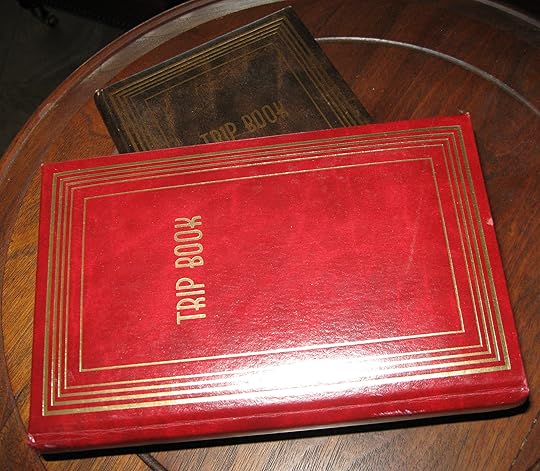
These small journals are superb. The red one went with me to England. The brown one went with me to Greece. The paper edges are gilded to keep out dust. They haven't faded in all these years. I wish they were still available.
But for my important, personal journals . . . for a long time I used cloth-covered hardcover sketchbooks. They were slim, had good-quality acid-free paper free of ruled lines, and cost very little at Borders. They came in an assortment of colors, and their propensity to catch dust helped remind me to keep my private journal tucked out of sight.

This journal looks pretty serious, doesn't it?
Then I strayed, and purchased a large leather-bound journal complete with place-marking ribbon. It's black with a classy ribbed spine. In fact, I consider it a tome. There's nothing about it that shrieks "Diary!" I've used it for several years now, and as its contents are over an inch thick, it can pretty much last a year before I run out of pages. It's designed to be refilled. Eventually I discovered that Levenger stocks refills that fit okay. ( Thanks, Steve! ) Handsome, excellent quality, and practical. Call me satisfied.

These refills happen to fit my leather cover fairly well. They're expensive, but they hold a lot.
And then there are the silk-covered journals. I have two. They shimmer with a depth and richness of color that makes me sigh each time I hold one. These have also been gifts. One is bold, luscious red. The other is a Moleskine in the most divine hue of bronzed apricot.
I.
Love.
Them.
So much so that I've never written a word in either. I keep waiting for the muse to let me know what they're for.
A friend once advised me to get over such beauty by putting a scribble on the first page. I can't bring myself to do it. I feel that these books should hold the plans and ideas for my Great American Novel, the story of such genius it will wow and astonish the world.
I know that's absurd and even unprofessional, but if writers, artists, and children do not cling to folly at least part of the time, what will become of us?
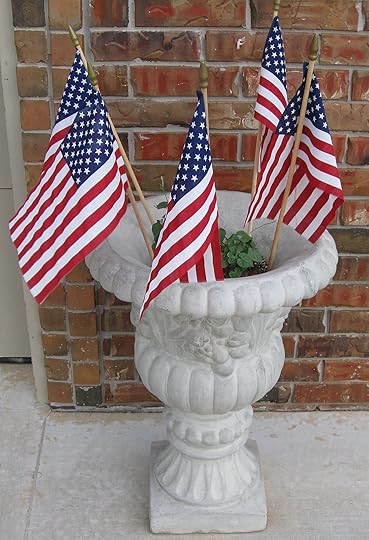
Hail set the morning glory vine back to a tiny stub, but aren't the flags pretty in this urn? I got the idea from Mr. Cottrell's Memorial Day display. Check out his blog at myoldhistorichouse.blogspot.com.








June 30, 2011
Dost Thou a Diary Keep?
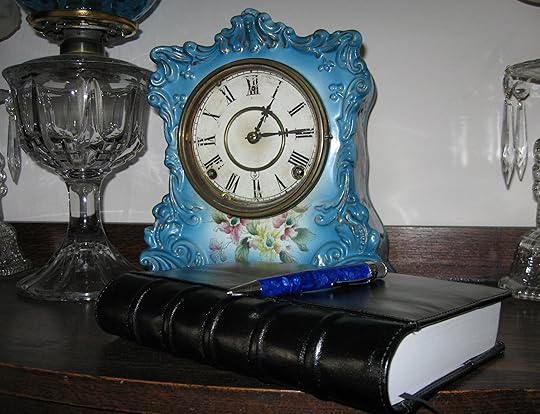
An old china clock, my favorite journal, and a good pen.
Once upon a time, long, long ago, and far, far away, I decided to keep a diary. I was young. My friends at school were writing in diaries and making a big deal of it. If you were going to giggle over boys and sigh over the handsome actors in your favorite TV shows, then you needed a diary.
First problem: they were either white or pink, with heart-shaped keys. Too girly!
Second problem: they were expensive. How do you explain to your mom that you NEED an official diary, complete with lock, when you're already supplied with alternate forms of paper and notebooks? How do you get across the concept that spiral notebooks are for writing THE GREAT AMERICAN NOVEL, not scribbling about secret pinings for a senior boy named Dale? And if you explained about Dale, how was he going to be kept a secret?
Ah, the long-ago problems of adolescence.
When I reached college, my writing professor Jack Bickham recommended keeping a journal while writing a novel.
Eagerly, I secured a notebook and tried. And failed.
I found diary entries to be the most boring writing I'd ever tried to do. I couldn't sustain it, day after day. After all, what was I going to say? Dear Diary, today I wrote a bad story. It was 10 pages long, with two characters.
Of course, I had misunderstood what Jack was getting at. For him, it was a production log. How many pages a day he produced. Whether his attempt to try a new writing technique worked or needed rethinking. The date he started the manuscript. The date he finished the rough draft. His notes for revision, etc.
Jack was all about writing to the highest standard of craftsmanship he could achieve. He was all about producing a viable manuscript as quickly and as efficiently as possible. No excuses.
The production log worked for him. It was part of his process in creating stories.
I'm not that left-brained. The discipline of writing daily in a diary or journal just doesn't appeal to me.
Instead, I've found merit in keeping an emotional journal. I don't have to write in it daily. I don't have to fill it with dry, boring little bits of mundane information. Instead, I go to my journal when I'm stuck, frustrated, stymied, angry, or triumphant.
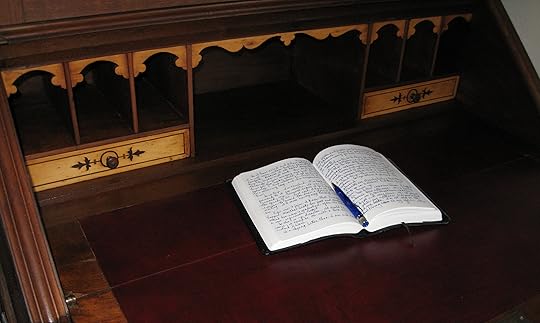
My current journal is about filled. I use a Tornado pen and Parker gel ink. Don't you like my old desk? I recently acquired it and haven't yet cluttered it with the usual desk litter. It won't take long.
I use it to plot out what's going to happen in the next scene. Or I use it to trace my satisfaction with how a challenging day at the keyboard went. Or I use it to moan over when a book signing is botched, misscheduled, or unattended. I use it to gloat when I get good reviews. I use it when I'm full of doubts and feel certain I'll never meet my deadline.
Often, my journal entries aren't about writing at all and deal instead with other emotional aspects of my life. That's okay. I don't have to force the journal in any direction. I am a writer. I live and breathe story. And I know that whatever I encounter in my day–even if it's only making a perfect loaf of bread–will be reflected somehow in my written work. Maybe not in the current project, but somehow, somewhere, someday.
As writers, we need an outlet–not just for the stories that spill from our hearts–but for what's happening to us as we create those stories.
It's a different way to express ourselves. And by providing that means of expression, we validate and encourage our muse yet again.








June 28, 2011
Visited Any Mummies Lately?
A cool way to feed the muse is to wander through museums. Now, maybe you don't care for them or you aren't interested in history or there aren't any in your immediate vicinity or you're leery of buying tickets to see some weird exhibit.
How many other excuses can you think up?
Museums exist in just about every community. They may be public or private. They may be art museums with big budgets and society patrons, or they may be bizarre little collections that Joe Strange has put together for his own amusement. Sometimes, they're as modest as an old house the local historical society has restored and filled with artifacts germane to the community.
I adore museums, but then I'm a writer–easily intrigued by collections, always eager to learn something new about the past, receptive to where serendipity might lead me.
For example, in Deming, New Mexico–a sleepy town maybe 30 miles north of the US-Mexican border–the museum is housed in the old armory and is much bigger than you might expect, given the size of the community. But what it lacks in population, Deming makes up for in its history. The museum's collections include Native American artifacts, cowboy and ranching gear, WWI items from when General Pershing's troops drilled outside the city, grainy old photos showing the devastation following Pancho Villa's notorious raid on Columbus, NM, a few short miles away, Victorian furniture donated by pioneer families, and numerous other items pertaining to local heritage. There's also the goofy section containing everything anyone has ever wanted to donate to the museum, including old hats and a whiskey-bottle collection.
Across the street is the fascinating old Customs House, its thick adobe walls cool against the desert heat. This is where goods hauled by wagon came out of Mexico up the trail to Santa Fe, and stopped in Deming for the customs inspector to levy his tariff. And there's a trap door leading down into the tunnels built beneath the streets, where Chinese workers used to hide on Saturday night from the rowdy cowboys that came in to shoot up the town.
Okay, so perhaps western history isn't your cup of tea. How about the Action Figure Museum in Pauls Valley, Oklahoma?
Too . . . plastic? Okay, try the British Museum in London. Once you get past security and prove to the guards that you are NOT carrying anything remotely resembling a bomb, you ascend a staircase leading to the enormous stone head of an Egyptian pharoah, smiling at you with the serenity of thousands of years. This is the epitome of museums, with its vast collections of incredible art, rows of Egpytian mummies and sarcophagi, and oh yes, that hangar-like space with a few scattered statues lying at one end. Can anyone say, Lord Elgin's marbles?
Or what about the carriage museum in Bath, England? Do you love reading Georgette Heyer's sparkling Regency romances? Well, here you can see exactly what a perch-phaeton looked like, or a racing curricle, or a brougham with a top that could be lowered if the weather were fine enough.

Sorry for the bad picture! This is an old English stagecoach, circa 1810.

Even worse picture quality! Age and acidity are taking their toll. This is a red Royal Mail coach, in England, circa 1800-1820.

Isn't the condition of this beautiful Regency dress amazing? Circa 1815.
Maybe you'd rather commune with the Charioteer in Delphi, Greece. There he stands, looking calm, while hordes of tourists press as close as the barricades and sandbags allow. (Why sandbags, you ask? To catch him if an earthquake knocks him over, of course!) And you can see that there's something odd about the old boy. He's extremely long-legged, out of proportion to his torso. What's wrong with the ancient Greeks? Didn't they understand anatomy?
Sure they did. And more importantly, they understood perspective. So the Charioteer was sculpted to be viewed from inside a chariot, at a distance. His legs were made extra long to allow for perspective and viewing angle.

The famous Charioteer at Delphi. He looks red, due to the acidity eating away my old photograph, but in reality he's green-patinated bronze.
But there are other things to see and study at museums besides old dinosaur skeletons and locomative prototypes and a cannon recyled from Napoleon's army to the Texas Republic. Museums, especially the big famous ones, attract people. And we writers love to watch people, don't we?
Consider a busy museum in Athens. A crowd gathers around some famous statue of Heracles, jammed so tightly that there's no opportunity for meek Americans to take pictures.
Enter a Frenchman with an expensive camera slung around his neck. His stride is sure. His voice is loud as he commands the crowd to step aside, s'il vous plait! People obey, parting like the sea, allowing him to take his picture. Clever American tourists learn to follow Monsieur through the museum, standing behind him to take pictures of all the important statues while he exercises superb crowd control.
Or consider the frail elderly lady being slowly conducted around a musty old house museum to see how her donated items have been labeled and put on display. Listen to her quavery voice reminiscing about her grandfather coming home from the state senate to put in a cotton crop.
Look at the rapt face of a three-year-old, staring at a costumed docent working an 18th century spinning wheel, while mama whispers to her, "And see the spindle where Sleeping Beauty pricked her finger?"
I haven't been to Venice, but I've seen the fantastic bronze horses of San Marcos because they traveled to the States on loan to the New York Metropolitan Museum.
I've walked through Mark Twains's boyhood house in Missouri, seen Andrew Jackson's hatbox in his Tennessee bedroom, and marveled at Thomas Jefferson's inventions, contraptions, and gardens at Monticello.
I've been gypped in tacky little Arizona trading posts offering glimpses of a South American mummy–poor thing–and yawned my way through poorly conducted tours of dingy little rooms containing dingy old photos of some dingy little blip of American history. I've gazed at the skeleton of a T. Rex, watched videos of how to nap flint with a deer antler, stood atop a mound made by the ancient peoples of the Mississippi valley, climbed a marble pathway to the glorious Parthenon, had my photo taken on the ramparts of a Frankish crusader's castle, and marveled at the crown jewels of England. I've gawked at the site where Anne Bolelyn was beheaded, inhaled the amazing fragrance of a field of orange trees in bloom while creeping about the ruins of a place called Tiryns–perhaps Odysseus's palace–and gazed at the plains of Sparta. I've strolled the gardens in Colonial Williamsburg, laughed through Restoration plays, and–perhaps most awe-inspiring of all–sat in Thomas Jefferson's seat in the Virginia House of Burgesses.
I've surveyed Edgar Allen Poe's college dorm room, peered at a letter written by Queen Elizabeth I–what penmanship!–in the private collection of the Duke of Devonshire, and been nearly blinded by the garish gold and red decor in the Duke of Wellington's house. There's also a nine-foot-tall nude marble statue of Napoleon in the foyer. It's a stunner, and not in a positive sense. (I'm told that it was donated to Wellington, and he hated it. He used to hang his hat on Napoleon's head every evening as he went up the stairs.)
Thanks to the behind-the-scenes tour at Biltmore House, I know how the Vanderbilts air-conditioned their summer cottage in North Carolina.
I think by now it's evident that history of all kinds inspires me. What inspires you?
I'll bet there's a museum somewhere devoted to it.








June 20, 2011
Little Chats
What? Talking to people? Talking to strangers? Leaving the safety of my keyboard and monitor and actually going outside to approach a flesh-and-blood human being? No way!
There was a time when the prospect of my doing exactly that gave me chills. As long as my wellspring of imagination was flowing freely, I believed I could dodge talking to others. Now I know better. There is value in staying connected with people of all types, of seeing real human nature and not just what other fiction writers present as human nature.
Not all writers are introverts, but I suppose a hefty percentage of them fall into that group. I'm introverted with a capital I. It took me a number of years and a lot of practice to get used to chatting with people, especially strangers. I had the notion–as hard to eradicate as crab grass–that as a writer I should remain detached from other people and just observe them.
Phooey!
Sure, you're observing all the time, but you need to get acquainted with all sorts of people, from a variety of backgrounds, and different ages.
Do you only hang out with other writers? Other writers your age?
What are you going to learn from them? (Okay, maybe they give you honest feedback when you read a scene aloud for critiquing, but are they feeding your muse?)
Writers need a wide range of information. We need different perspectives, different angles. We need to see the oddities among people as well as the similarities. Personalities, mannerisms, intensity of focus versus ditz-brain, domineering and meek–the combinations go on endlessly.
Probably the easiest gambit is to ask questions about what someone does. Not: "Do you make a decent living?" But: "How long have you been a parking monitor? How many tickets a day do you write? Does that gizmo you're holding really run a check on a car's license tag?"
Most folks are flattered when you start asking them questions about what they do or something they know. If your interest is genuine, they'll usually open right up. Suddenly you may find yourself receiving insider perspective and your fiction will benefit from it.
So if you're going to write about a character that's a psychiatrist, talk to a doctor informally away from the office. If you're going to write about a skydiver, drive out to an airfield where people throw themselves out of airplanes for fun. Watch what they do and talk to them about it. Unless you're researching for very specific information, you don't need a list of regimented questions. You're just showing interest.
I find it the most fun to get to know elderly people who are still vibrant and active. They have perspective, insight, wisdom, experience, and forceful opinions. They may be raconteurs who tell terrific stories. They may be still running a business with little time to spare. But if you get to know them, you'll come away with copious amounts of story inspiration.
For me, the most difficult people to talk to can be children. After a while, I figured out that the key is not to ask dorky grownup questions, but instead to use patience and demonstrate real interest in whatever the kids happen to be doing. If you don't rush them, pretty soon they're climbing on you, eager to tell you all kinds of things.
Even more importantly, once you have someone talking, keep your mouth shut and LISTEN. Once people start sharing with you, it's their show, not yours. The better you listen, the more they'll say.
I know this is all basic advice for good conversation of any kind, but as a writer I had to learn how vital it is to touch reality from time to time. The more I connect with people, the more gold I have from which to spin my webs of dreams.








June 19, 2011
On the Road Again
In the 18th century, travel was challenging, difficult, expensive, exhausting, and dangerous. (Sound familiar?)
Rich folks of that era didn't have expedia.com to help them plan and book reservations. Instead, they had to write ahead to inns along their route to reserve accommodations and spare horses. They loaded up the carriage they'd ride in, a carriage for their servants to ride in, and a wagon for the luggage. At speeds of three to five miles per hour, they braved the hazards of mud, ruts, dust, bandits, broken wheels, etc. They had to reach the inn where they'd made reservations before dark because there weren't any street lights. Or head lights, for that matter. They packed their pillow, their own sheets and towels, their favorite books, a hamper of food, and perhaps a caged canary to whistle some tunes. They played cards instead of texting. The very rich or persnickety took along their personal chef.
Once they arrived at their friend's home, they stayed for at least six weeks because who would go to so much expense and trouble for just a weekend visit?
Well, travel today isn't quite that difficult, although once you've sat on a plane for an hour, waiting for the gate to be cleared so you can disembark, while the five-year-old behind you kicks your seat and chants "Why can't we get off? Why can't we get off? Why can't we get off?" and an elderly lady argues with the stewardess who won't let her use the restroom as long as we're on the runway, you might ask yourself if it was worthwhile to leave home.
I no longer travel via planes because my allergies have made it too difficult. I need certain food items and special drinking water. I need my own pillow. A hotel's cleaning products can trigger an attack, so I drag along an air purifier or move to a different hotel. Earlier this year, when I ventured off for a 12-day trip, my dogs' boarding fees cost more than my own accommodations. And if I'm driving across a state where all the gas pumps contain ethanol, it's best to rent a car rather than use my own. (The last mechanic's bill to resusitate my car after one tank of substitute fuel was staggering!)
Like most writers eager to gain new experiences and perspectives, I've done my share of roaming. I've been to both coasts and overseas. I've traveled via car, plane, train, and ship. And I've discovered that when it comes to writers gleaning inspiration and filling the well, it's unnecessary to go to major expense or obtain a passport.
Day trips are delightful, economic ways in which to feed the muse. Just the act of merging onto the interstate, knowing I'm headed out of town for the afternoon, is enough to kick my imagination into a new gear. I may travel less than 50 miles from home, but it's enough to shake off the cobwebs, focus nearsightedly on something other than a computer screen, and feel the exhilaration of adventure, however modest.
This doesn't mean that I'm ruling out the big, fabulous trips. But if you're stuck at home, scrimping and saving for months or years for that once-in-a-lifetime journey, how are you going to fill the well in the meantime?
Sometimes, the well doesn't have to overflow; all it may need is a gallon or two.








June 17, 2011
A Rut By Any Other Name . . .
Take a different route to work, or when you run errands.
Yeah, yeah, yeah. Haven't we all encountered this advice before in help-for-writers books? Yawn, snore, whatever.
Don't discount it. Old advice can still be useful advice.
The point is–as I'm sure we all recognize–to avoid sticking yourself in ruts. Not just when you're driving, but in any aspect of your life.
It's your responsibility to keep yourself as creative, fresh, passionate, and enthusiastic as possible.
When you're a writer, beware the routines so ingrained, so habitual, that you don't even notice them anymore.
(Okay, I know. Brushing your teeth before bedtime should be an ingrained habit. Notice I said beware, as in be aware of, not ditch.)
Writers shouldn't operate on auto-pilot. We must observe. We need to remain focused on our environment–watching and seeing as much as possible.
I tend to be a trifle OCD. That's helpful in meeting book deadlines and tracking details when building worlds in my fantasy novels. It also can leave me in ruts as deep as trenches.
For example, I want the fastest, most efficient way to my day job–meaning a drive encountering as few stoplights and school zones as possible. Nothing wrong with that. If I'm running behind because I started plotting while in the shower and lost track of time, then I have to arrow my way across town.
However, efficiency and artistry are not always compatible.
Life has helped me out. Recent street construction now blocks my habitual trail, forcing me to detour into neighborhood streets I've seldom or never driven before.
Even better, artistically speaking, the detours change from week to week. So one day I may be passing a string of tiny, ramshackle houses built after WWII with weed-patch yards and the fatigued look that old, neglected houses acquire on the road to becoming derelict. Look! There's a scrawny alley cat stalking prey among the shrubs marking a property line. Look! Is that child actually urinating off the front porch?
He's old enough to know better! Where are his parents? Maybe they're asleep because they work nights. Maybe they've gone to steal identities from mailboxes to support their meth habit. Maybe they've split up, and Mom can't watch the kids because she has to work. Maybe Uncle Bobby's moved in again and hogs the bathroom.
Now my imagination's clicking, playing the "what if?" game. I may never write a story with this setting. I may simply transfer the experience–using my sense of shock, outrage, and amusement to fuel the emotions of a character in an entirely different scenario. Doesn't matter. My muse is working.
On another day I may be zigzagging through a crummy commercial district interspersed with blocks of tidy 1960s tract houses. Look! There's a crane looming over a house like a Triffid. The buzz of chainsaws fills the air. Are they really going to take down that ancient elm? Why didn't they cable the branches before it was too late?
And my memories wheel to another decade, when an elm dropped a massive limb on my next-door neighbor's roof, punching through the kitchen ceiling. I think of when I hired the removal of a large, hollow silver maple threatening my garage and how the tree huggers on the block emerged like wood beetles to gripe and chastise me. Never mind that I planted a smaller variety of tree better suited for the site or that I fed the squirrels, wild birds, and field mice copious amounts of seeds and grain; I was forever labeled a Destroyer of the Habitat.
The what if? game starts. Dialogue and scenes swirl in my thoughts.
Oh, darn! I'm late for work again.








C. Aubrey Hall's Blog
- C. Aubrey Hall's profile
- 7 followers







